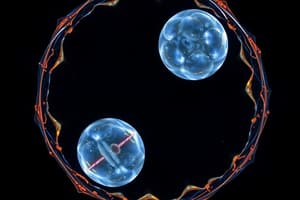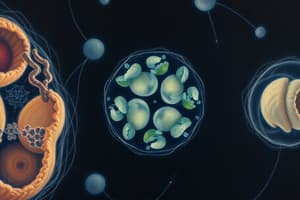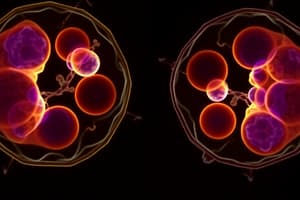Podcast
Questions and Answers
Which of the following accurately describes the role of kinetochores during cell division?
Which of the following accurately describes the role of kinetochores during cell division?
- They initiate DNA replication during the S phase.
- They facilitate the condensation of chromatin into visible chromosomes.
- They regulate the formation of the cell plate in plant cells.
- They serve as the attachment points for spindle fibers to separate sister chromatids. (correct)
A researcher observes a cell undergoing DNA replication. In which phase of the cell cycle is this cell?
A researcher observes a cell undergoing DNA replication. In which phase of the cell cycle is this cell?
- M phase
- G1 phase
- G2 phase
- S phase (correct)
How does cytokinesis in plant cells differ from cytokinesis in animal cells?
How does cytokinesis in plant cells differ from cytokinesis in animal cells?
- Animal cells use vesicles from the endoplasmic reticulum, while plant cells use vesicles from Golgi apparatus.
- Plant cells undergo cytokinesis before mitosis, while animal cells do so after.
- Plant cells form a cleavage furrow, while animal cells build a cell plate.
- Animal cells form a cleavage furrow, while plant cells build a cell plate. (correct)
What is the most critical outcome of high fidelity DNA replication during cell division?
What is the most critical outcome of high fidelity DNA replication during cell division?
Which of the following correctly matches a cellular structure with its function during cell division?
Which of the following correctly matches a cellular structure with its function during cell division?
A researcher observes a cell undergoing division. The chromosomes are aligned along the metaphase plate, but the spindle fibers appear to be non-functional. What is the most likely outcome of this division?
A researcher observes a cell undergoing division. The chromosomes are aligned along the metaphase plate, but the spindle fibers appear to be non-functional. What is the most likely outcome of this division?
If a somatic cell with 46 chromosomes undergoes mitosis, how many chromosomes will each daughter cell have?
If a somatic cell with 46 chromosomes undergoes mitosis, how many chromosomes will each daughter cell have?
A scientist treats cells with a chemical that inhibits the function of the centromere. Which stage of mitosis would be most affected?
A scientist treats cells with a chemical that inhibits the function of the centromere. Which stage of mitosis would be most affected?
Which event occurs during the S phase of the cell cycle?
Which event occurs during the S phase of the cell cycle?
A student is asked to explain the primary difference between mitosis and meiosis to a younger student. Which of the following explanations is most accurate?
A student is asked to explain the primary difference between mitosis and meiosis to a younger student. Which of the following explanations is most accurate?
A researcher discovers a new drug that blocks cytokinesis in animal cells. What direct effect would this drug have on dividing cells?
A researcher discovers a new drug that blocks cytokinesis in animal cells. What direct effect would this drug have on dividing cells?
During plant cell cytokinesis, a cell plate forms to divide the cell. What is the origin of the cell plate?
During plant cell cytokinesis, a cell plate forms to divide the cell. What is the origin of the cell plate?
A particular mutation causes a cell to skip the G1 phase of the cell cycle. What is a likely consequence of this mutation?
A particular mutation causes a cell to skip the G1 phase of the cell cycle. What is a likely consequence of this mutation?
Flashcards
Cell Division Function
Cell Division Function
Enables growth, repair, and reproduction in multicellular organisms.
S Phase
S Phase
The phase of the cell cycle where DNA is replicated.
Human Chromosome Number
Human Chromosome Number
Human somatic (body) cells contain 46 chromosomes arranged in 23 pairs.
Centromere
Centromere
Signup and view all the flashcards
Mitosis
Mitosis
Signup and view all the flashcards
Interphase
Interphase
Signup and view all the flashcards
Cell Plate
Cell Plate
Signup and view all the flashcards
Apoptosis
Apoptosis
Signup and view all the flashcards
Mitotic Spindle
Mitotic Spindle
Signup and view all the flashcards
Cytokinesis Difference
Cytokinesis Difference
Signup and view all the flashcards
Fidelity of DNA Replication
Fidelity of DNA Replication
Signup and view all the flashcards
Chromatin
Chromatin
Signup and view all the flashcards
Study Notes
- These notes cover key concepts related to cell division, including mitosis, meiosis, and the cell cycle
Cell Division Functions
- Enables reproduction, growth, and repair in multicellular organisms
S Phase
- DNA is replicated during the S phase of the cell cycle
Chromosome Number
- Human somatic cells contain 46 chromosomes
Centromere
- The centromere holds sister chromatids together
Mitosis
- Interphase is not a phase of mitosis
G1 Phase
- The cell grows and prepares for DNA replication during the G1 phase
Mitosis Outcome
- Mitosis does not produce four genetically identical daughter cells
Chromatin
- Chromosomes are made of chromatin, a complex of DNA and proteins
Cytokinesis
- A cleavage furrow does not form during cytokinesis in plant cells
Mitotic Spindle
- The mitotic spindle separates chromosomes during cell division
Mitosis
- The process of cell division resulting in two identical daughter cells
Interphase
- The phase of the cell cycle is where the cell grows and prepares for division
Cell Plate
- The structure that forms during plant cell cytokinesis
Chromatin-Associated Proteins
- These proteins help control gene activity and maintain chromosome structure
Apoptosis
- Programmed cell death
Mitosis vs. Meiosis
- Mitosis produces two genetically identical diploid cells
- Meiosis produces four genetically unique haploid gametes
- Mitosis is for growth and repair
- Meiosis is for sexual reproduction
Mitotic Spindle Role
- Made of microtubules
- Organizes and separates chromosomes during mitosis
- Attaches to chromosomes at the kinetochores
- Pulls sister chromatids apart during anaphase
S Phase Events
- The cell replicates its DNA
- Each daughter cell receives an identical copy of the genome
Cytokinesis Differences
- In animal cells, a cleavage furrow pinches the cell in two
- In plant cells, vesicles from the Golgi apparatus form a cell plate
- The cell plate develops into a new cell wall
DNA Replication Fidelity
- Ensures each daughter cell receives an exact copy of the genetic material
- Maintains genetic stability and proper cellular function
Matching Answers
- Chromatin: A complex of DNA and proteins that makes up chromosomes
- Centromere: The region where sister chromatids are joined
- Kinetochore: A protein structure on chromatids where spindle fibers attach
- Cytokinesis: The division of the cytoplasm following mitosis
- Interphase: The phase of the cell cycle where the cell grows and prepares for division
Studying That Suits You
Use AI to generate personalized quizzes and flashcards to suit your learning preferences.




